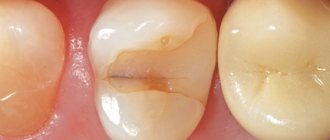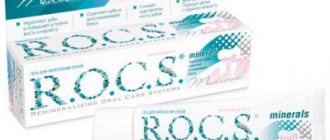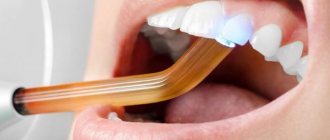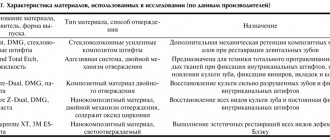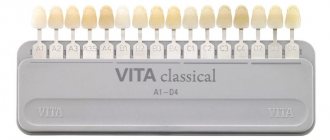If the filling interferes after treatment
Even in the doctor’s office, after installing the filling, be sure to make sure that the restored tooth is not in the way (move your jaw back and forth, sideways, carefully close your teeth). The filling should not be felt or change the bite. Don’t be shy about talking to your doctor about any discomfort—sometimes the final stage of filling treatment can take even longer than removing cavities and applying filling material.
After treatment, anesthesia wears off within 1.5-2 hours. If a conductor type was used, then after 4-6 hours. Now you are beginning to fully feel the treated tooth, you can fully close your jaws and understand how comfortable you are after filling.
If you experience slight discomfort, it feels like the tooth is a little larger and your jaws aren't closing quite tightly—this is normal. The fact is that now you have been given a new filling in accordance with the bite, that is, with the shape and position of the tooth located on the opposite side. The treated tooth became taller than before - after all, there was caries and the old filling sagged. Therefore, if there is no sharp pain and obvious rejection, be patient for a few days. If the situation normalizes and you get used to it, then there is no reason to see a doctor. If discomfort persists for 1-2 weeks, you should visit your dentist to have the filling corrected.
How long should you not eat after having a filling installed?
If a filling made of chemical composites is installed, then you should refrain from eating and drinking for 2 hours. This is due to the fact that the material requires a certain time for final shrinkage and hardening.
If a “light” composite filling is installed, you can drink immediately, but you should abstain from food for 1.5-2 hours. But the reason is not in the material (it hardens a few seconds after application), but in anesthesia - with reduced sensitivity of the mucous membranes during eating, you can injure the tongue and mucous membranes of the cheeks on the inside.
During the day after the filling is installed, you should only eat warm foods - excessively hot or cold foods can lead to changes in the shape of the filling. It is necessary to chew food on the opposite side for the first day - this will allow the material to fully “adhere” to the tissues and take the desired shape, without the risk of damage.
Why does a tooth hurt after a filling is installed?
Minor soreness may persist for several days or even a couple of weeks, which is explained by overheating of the tissue due to the use of boron. In some situations, for example, with deep caries or when treating front teeth, increased sensitivity can persist even for several months. But in such a situation, you should still consult a doctor for an x-ray to make sure that there is no infected tissue left under the filling and that inflammation has not affected the nerve.
If the pain intensifies, the filling darkens, black spots appear under it - all this indicates that the treatment was carried out poorly and re-inflammation has begun. This is a reason to see a doctor as soon as possible.
Alarming symptoms during the recovery period
There are a number of clinical manifestations that should alert the patient and force him to see a doctor. They include:
- Severe throbbing pain in the tooth after caries treatment;
- Increased temperature (low-grade, febrile, constant or periodic - always requires seeing a doctor);
- Bleeding gums around the treated tooth;
- Attacks of pain that occur at night and interfere with sleep;
- General signs of the inflammatory process (weakness, malaise, lack of appetite, and so on);
- Increased tooth sensitivity, which was not noted before treatment (even to the point of giving up many products);
- Numbness of the treated area;
- Discoloration of the gums around the affected tooth;
- Swelling of the gums and cheeks, which gradually increases;
- Loosening of the treated tooth.
All of the listed symptoms, especially in combination with severe pain, are a direct indication for a return visit to the dentist.
What to do if your gums hurt after filling
The gums in the area where the anesthesia was administered may ache for several days - this is completely normal and does not require any measures. The mucous membrane may also be slightly inflamed if special rings were used during treatment, which are placed on the tooth to form the correct shape of its crown. The gums can also be damaged if the doctor had to install the filling material in close proximity to the mucous membrane or even under it - in such a situation the gums are deliberately pushed back. Therefore, pain is a normal reaction to external intervention.
All of these conditions are variations of the norm. But if the pain intensifies, redness and swelling of the mucous membrane progresses, you need to consult a doctor.
How to properly perform hygiene procedures
After treatment, brush the filled tooth carefully, applying minimal pressure to it. Do not use rinses containing abrasive substances and alcohol, which can increase the plasticity of the material - this will lead to a change in the shape of the filling. Also, do not use excessively hard brushes - they can leave microcracks in the material, which will quickly damage it.
In general, you should take care of teeth with fillings in a completely standard way:
- daily brushing of teeth twice a day - in the morning before breakfast and in the evening after all meals, after - rinsing the mouth with water and rinse,
- To clean the area of filled teeth after eating, it is better to replace dental floss with an irrigator. If you floss carelessly, you can touch the installed filling, especially if there are thin edges of the tooth, which will lead to its loss.
Other causes of tooth pain after treatment
Pain from an overbite filling
After installing the filling, the dentist polishes it along the bite, but only the patient can tell when biting whether it bothers him or not. Because dental treatment is often performed under anesthesia, numbness in the mouth makes it difficult to determine the height of the filling. After the anesthetic wears off, pain appears when biting when the opposite tooth presses on the over-inflated filling, and it puts pressure on the pulp.
There is a widespread belief that the filling will wear out over time and there is no need to bother the doctor again to correct it. This is wrong, since modern filling materials are incredibly durable and will take years to wear out. Due to malocclusion, patients will experience constant pain and discomfort; over time, the surrounding tooth tissue may become inflamed, which will lead to the need for repeated treatment. The filling grinding procedure is absolutely painless, so don’t delay your visit to the dentist.
Allergy
In rare cases, dental allergies occur - the body’s reaction to an installed filling. Allergic symptoms in the first days after visiting the dentist resemble signs of an inflammatory process: constant pain in the area of the treated tooth, swelling and redness of the gums. Local manifestations of allergies may be accompanied by general symptoms, such as skin rash or itching.
It is impossible to cure an allergy to filling material on your own; if the diagnosis is confirmed, the dentist will replace the installed filling with a less allergenic one.
Is it necessary to follow a diet after caries treatment?
From the diet as a whole after caries treatment (especially if a large filling is installed and your own tooth has very thin walls), it is recommended to remove too hard foods - toffees, chewing gum, grilled fruit, nuts, etc. Or chew them with teeth located on the opposite side (if they do not have fillings).
Minimize the amount of consumed foods and drinks that contain coloring pigments (tea, coffee, beets) - under their influence, the filling material may slightly change its shade. This rule is especially relevant when restoring front teeth.
Following recommendations after caries treatment
The duration and general presence of pain depend on the correctness of the rehabilitation period and the implementation of the recommendations given by the doctor. These include:
- Smoking ban;
- Limiting foods with dyes;
- Limiting the consumption of foods that are too hot or too cold;
- Refusal from solid food during rehabilitation, requiring effort when biting (nuts, apples, etc.);
- Prohibition on the use of chewing gum;
- Limiting the consumption of sweets;
- Careful oral hygiene according to the algorithm that the dentist will tell you (do not over-clean your teeth with a hard brush).
Recommendations also include drug therapy, which includes painkillers, anti-inflammatory drugs, a course of antibiotics for the treatment of advanced lesions, antiseptic rinses and the application of special ointments.
How to maintain your treatment guarantee
As a rule, therapeutic treatment, that is, dental filling, is guaranteed from 6 months to 2 years - depending on the volume of work and the complexity of the situation. To maintain the guarantee, the patient must strictly follow all recommendations: do not overload the tooth, do not use it for other purposes (for example, open beer bottles), and also regularly see the doctor in accordance with the individual schedule of medical examinations. Unfortunately, many patients forget about this, and it is the last point that is the key to maintaining the guarantee for treatment.
You need to visit a doctor 1-2 times a year. During a preventive examination, the dentist will be able to make sure that the filling is in good condition and that caries does not develop again underneath it.
What to do if a child has a toothache -
If a child has a toothache, how to numb the pain will depend on his age. In children over 6 years of age, it is optimal to use the drug Nurofen 200 mg (contains the NSAID ibuprofen), which is approved from 6 years of age. This drug will not only help relieve severe pain, but also has an anti-inflammatory effect (Fig. 9).
In children aged 3 months and older, it is also optimal to use an NSAID-based analgesic, for example, children's Nurofen in suppositories for the youngest, and in suspension for older children (Fig. 10-11). The package of Nurofen Baby suspension contains a special dispenser that helps measure the required amount of the drug, as well as a diagram that helps to calculate the volume of the drug depending on the child’s body weight.
In addition to Nurofen, from 2-3 months, a child can also use paracetamol-based analgesics, for example, children's Panadol in the form of a suspension (Fig. 12). Each 5 ml of suspension contains 120 mg of paracetamol.
The volume of suspension/dose of paracetamol will depend on the age (body weight of the child). The drug is taken 3-4 times a day, single doses of the drug in “ml” and “mg” depend on the age of the child - are indicated in Table 1. The permitted dose of paracetamol depending on the child’s body weight is -
| Body weight (kg) | Age | Paracetamol dose | |||
| One-time | Maximum daily | ||||
| ml | mg | ml | mg | ||
| 4,5-6 | 2nd month of life | Only on doctor's orders | |||
| 6-8 | 3-6 months | 4.0 | 96 | 16 | 384 |
| 8-10 | 6-12 months | 5.0 | 120 | 20 | 480 |
| 10-13 | 1-2 years | 7.0 | 168 | 28 | 672 |
| 13-15 | 2-3 years | 9.0 | 216 | 36 | 864 |
| 15-21 | 3-6 years | 10.0 | 240 | 40 | 960 |
| 21 -29 | 6-9 years | 14.0 | 336 | 56 | 1344 |
| 29-42 | 9-12 years | 20.0 | 480 | 80 | 1920 |

